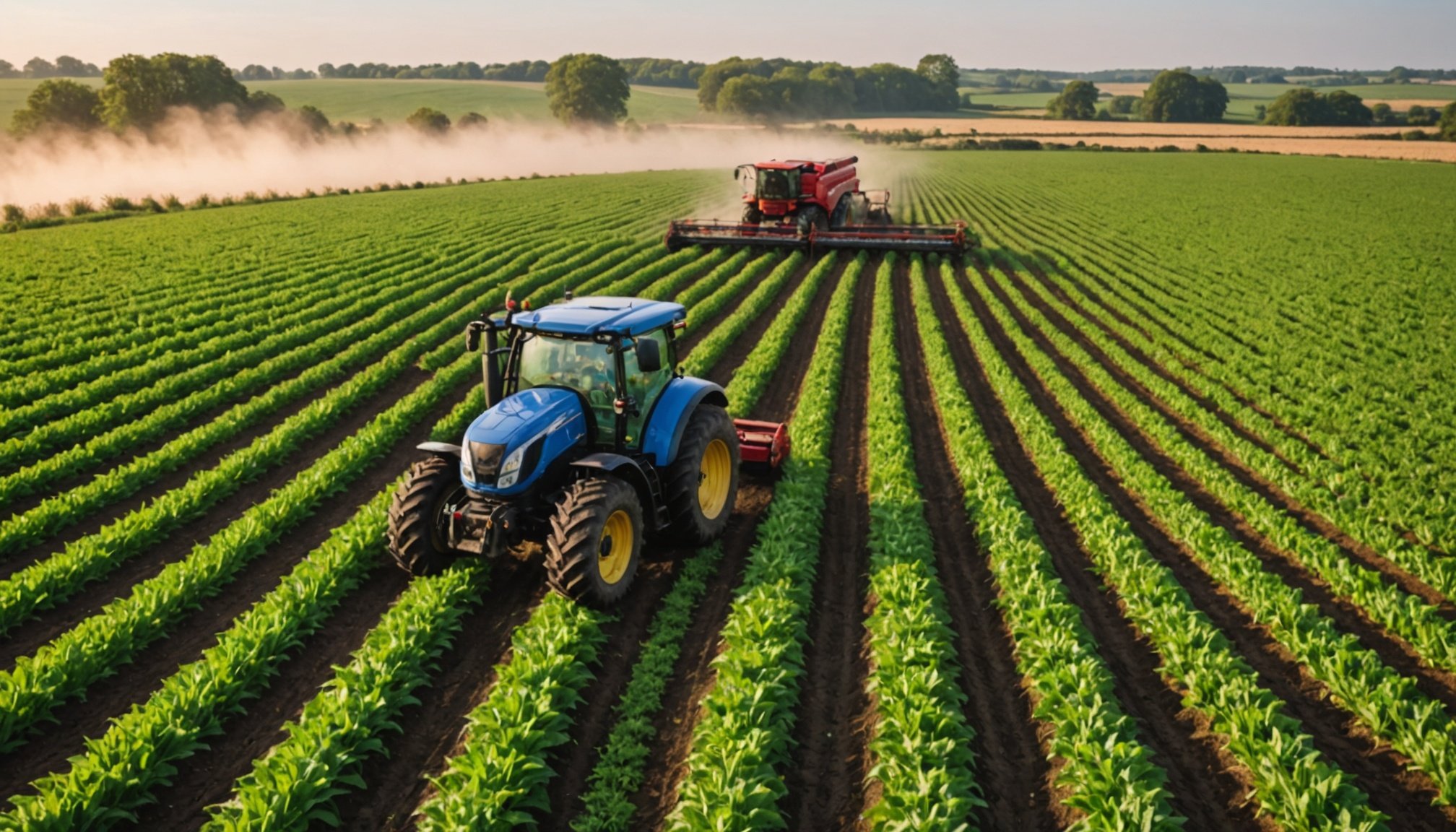Overview of IoT in UK Farming
The deployment of IoT in agriculture has ushered in an era of smart farming throughout the UK, fundamentally transforming how farmers monitor and manage their crops. IoT in agriculture refers to the integration of internet-connected devices with agricultural processes. This setup enhances productivity by providing precise, real-time data, thereby revolutionising conventional farming methods. With the smart farming approach, farmers can improve crop yield and decision-making, crafting a more sustainable agricultural future.
Impact on Crop Monitoring and Yield Enhancement
Initially, crop monitoring was a labour- and time-intensive task. However, crop monitoring technologies powered by IoT have turned this into a swift, data-driven activity. Sensors strategically placed in fields collect vital information such as soil moisture, temperature, and nutrient levels. This data helps farmers tailor their interventions precisely, ultimately boosting crop yield.
This might interest you : Greening UK Manufacturing: Essential Strategies for Sustainable Production Practices
Key IoT Technologies in UK Farming
In the UK, farmers are increasingly adopting various IoT technologies like soil moisture sensors, weather stations, and GPS tracking systems. These technologies provide a comprehensive analysis, allowing for targeted interventions. Additionally, crop monitoring technologies aid in early detection of diseases and pests, safeguarding yields in an efficient manner. By employing smart farming techniques, UK agriculture is on a path toward greater efficiency and productivity.
Applications of Drone Technology in Agriculture
Drone technology is transforming how farmers approach precision agriculture by offering an aerial perspective of crop fields. In the UK, various types of drones, such as multi-rotor, fixed-wing, and hybrid models, are employed based on their specific functionalities. Multi-rotor drones, for example, are adept at aerial crop monitoring in smaller areas, while fixed-wing drones can cover expansive fields efficiently.
In parallel : Transforming Menus with AI: Top Strategies for UK Restaurants to Boost Culinary Creativity
The benefits of using drones in agriculture are substantial. They provide high-resolution aerial imagery and data, allowing for precise crop assessment. This capability aids in monitoring plant health, identifying irrigation issues, and assessing damage after extreme weather events. Furthermore, drones facilitate targeted interventions, thereby optimizing resource use and minimizing waste.
Real-world examples illustrate the successful adoption of drone technology. For instance, many farms have reported improved crop management efficiencies and yield enhancements by integrating drones into their existing practices. The ability to swiftly gather and analyse comprehensive data ensures that farmers are better equipped to make informed management decisions, ultimately leading to enhanced agricultural productivity. By harnessing drone technology, UK agriculture is poised for continued advancement in precision agriculture practices.
Benefits of IoT and Drones for Crop Monitoring
The benefits of IoT and drone technology in agriculture are transforming crop monitoring, enhancing both accuracy and efficiency. With advancements in IoT, farmers gain access to real-time data, providing a comprehensive overview of their crops’ health and environmental conditions. This data accuracy allows for real-time monitoring, ensuring timely responses to any issues that may arise.
Additionally, the incorporation of IoT and drones leads to significant cost savings and resource optimization. By utilising precise data, farmers can conserve resources such as water and fertilisers, applying them only when needed. This not only reduces expenditure but also minimizes environmental impact.
Moreover, decision-making in agriculture sees vast improvements through the use of analytics and data-driven insights. The integration of technology equips farmers with detailed analyses and forecasts, paving the way for strategic planning and proactive management. Drones play a crucial role, delivering high-resolution imaging and data from an aerial vantage point, thus complementing IoT sensors on the ground.
In essence, the fusion of IoT and drones amplifies agricultural efficiency, bolstering productivity while supporting sustainable practices. With these technologies, farmers are better equipped to meet the growing demands of modern agriculture.
Case Studies of Successful Implementation
The adoption of IoT and drone technology in agriculture has led to several compelling case studies in the UK. These IoT success stories highlight the innovative ways in which farms are leveraging technology. For instance, one farm in East Anglia introduced smart farming with IoT sensors and drones, resulting in a 20% increase in crop yield within a year. The integration of these technologies provided real-time insights into soil health and crop conditions, allowing for precise interventions.
Another notable example is a drone-driven initiative in Yorkshire focusing on aerial crop monitoring. By employing a fleet of drones, the farm improved pest control efficiency and minimized the use of pesticides, leading to healthier crops and a 15% cost reduction.
These successful implementations provide key metrics and lessons learned. They demonstrate how combining IoT and drones can enhance agricultural efficiency, improve yield, and optimize resource use. The scalability potential is evident, encouraging more farms to adopt these technologies. As these case studies illustrate, the integration of technology is not only feasible but advantageous, setting the stage for transformative shifts in modern farming practices.
Challenges in Adopting IoT and Drone Technologies
The integration of IoT and drone technologies in farming presents numerous advantages; however, it also brings specific challenges. One primary barrier to adoption is the cost of technology. Many farmers find the initial investment in these advanced systems prohibits widespread use. Additionally, infrastructure limitations in rural areas may complicate the implementation, especially for internet-reliant IoT devices.
Another significant concern is data security and privacy. With the use of IoT, vast amounts of data about farming operations are collected. Farmers worry about how this data is stored, shared, and potentially misused, thereby necessitating stringent security protocols and transparent data policies.
Successful adoption requires addressing these obstacles through strategic solutions. For instance, developing flexible pricing models can make technology more accessible. Meanwhile, government incentives, such as subsidies, can offset costs. Ensuring robust cyber-security measures and educating farmers about these technologies can also assuage fears surrounding data privacy.
To combat challenges, farmers can collaborate with tech companies to ensure continuous support and updates. By tackling these barriers, the farming sector is better positioned to harness IoT and drone technologies effectively, enhancing overall agricultural innovation and sustainability.
Best Practices for Integrating Technology in Farming
Adopting technology integration in agriculture demands methodical approaches to ensure sustainable success. Farms aiming to benefit from smart farming strategies should follow key practices. Steps for implementation include piloting technologies on a smaller scale before a full rollout. This allows farmers to understand system efficiencies and address any operational challenges early.
Comprehensive training and education are paramount. Farmers must familiarize themselves with IoT systems and drones, enhancing their skill set to manage emerging technologies efficiently. Many agricultural institutions now offer workshops tailored to modern technological tools, equipping farmers with necessary expertise.
Collaboration plays a pivotal role. Engaging with tech firms facilitates smoother integration, as these companies offer bespoke solutions and ongoing support. In addition, agricultural stakeholders bring valuable insights into market needs and environmental considerations.
When considering smart farming strategies, consult with fellow farmers who have successfully integrated technology, sharing best practices and troubleshooting tips. By leveraging collaborations and education, the farming sector can effectively navigate challenges associated with technology integration while reaping long-term productivity gains. This approach not only boosts individual farm efficiencies but also fortifies the larger agricultural community against future challenges.
Future Trends in Agricultural Technology
The future of farming is rapidly evolving with the anticipated growth of IoT and drone usage over the next decade. The integration of agricultural technology trends promises to further transform traditional practices, driving innovation and efficiency. As sustainability and climate change become ever more pressing concerns, innovations in agriculture will increasingly focus on minimizing environmental impact while maximizing productivity.
One emerging trend is the development of autonomous systems and AI-powered machinery, which aim to simplify and enhance farming operations. These technologies have the potential to reduce reliance on manual labour by performing complex tasks with precision and efficiency.
Moreover, advanced analytics and machine learning are poised to play a critical role in predictive modelling, helping farmers forecast weather patterns and make informed decisions about crop management. This will lead to improved resource allocation and yield optimization.
As sustainability becomes a focal point, technologies that promote resource conservation like automated irrigation systems and renewable energy solutions are anticipated to gain prominence. Exploring new farming methods such as vertical farming and hydroponics also shows promise in addressing land use challenges while conserving water.
In the realm of climate change adaptation, the focus on developing crops resilient to changing weather conditions will be pivotal in future agricultural practice.











